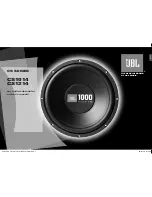
See figure 3.1.
If used with a 2-channel integrated amplifier, or
any source without a dedicated sub/LFE output,
you will need to use both the L and R inputs on
the UFW-12’s back panel from a low-level output
on your preamplifier or receiver. Often “Tape” or
“Monitor” outputs will provide an appropriate
low-level stereo signal if the dedicated output
does not exist. See figure 3.2 below…
Figure 3.2
Section 4—Setting Up Your Surround
Processor or Receiver
4.1 Small or Large?
Many of today’s surround processors and home
theater receivers will allow you to set all 5
speakers in your room to either small or large,
thus changing the way your UFW-12 interacts
with your system.
Like almost all things audio, which setting to use
is somewhat subjective, though it’s also a func-
tion of your room. By a good majority, most
rooms will obtain their best sound with all speak-
ers set to "small" and crossed over to the UFW-
12 at 80Hz. Of course this is assuming the use
of a high performance subwoofer such as the
UFW-12. A strong sub ideally placed will handle
sub-80Hz information better than "most" loud-
speakers in "most" rooms. This is mainly due to
the tendency for competing sources of informa-
tion below 80Hz to result in destructive bass
wave cancellation, thus eliminating the very fre-
quencies your subwoofer was designed to play.
In addition, when crossed over with your UFW-
12, the other loudspeakers in your system will
play with greater ease and less distortion, free
from the demands of deep and complex sub-
80Hz waveform reproduction.
Your speaker system amplifier will be less taxed
as well, since much of the stress of producing
deep bass will be eliminated. Consequentially
your loudspeakers should sound cleaner and
more controlled.
An easy and "user friendly" way to test different
methods and frequencies for crossing over your
subwoofer is to use low frequency sweeps re-
corded on special program material. One of our
favorite is the "AVIA Guide To Home Theater"
DVD. Specifically, the tones that descend in
frequency from the individual satellite speakers
to the subwoofer are quite useful and effective.
Using your SPL meter (explained in the following
sections), watch for the smallest amount of over-
all needle fluctuation while you direct and de-
scend the tones from speaker to subwoofer as
you go around your system. In other words, the
point at which the signal transitions between
your satellites and subwoofer should be com-
pletely seamless and without definition.
4.2 Simple Calibration
To begin configuring your subwoofer for opti-
mum performance (a) in your room and (b) in
combination with your other loudspeakers, you’ll
first need a Sound Pressure Level (SPL) meter.
Radio Shack sells an analog SPL meter (shown to
the left) that works very well for this purpose.
Set the meter to "Slow" with a “C” weighting.
The dial should be set at either 70 or 80 depend-
ing on your pre/pro or receiver’s
test tone level. Consult your
owner’s manual to determine what
reference point your unit uses.
Most use 75dB, so the "70" setting
on the meter would be appropriate
for them.
Let's start by setting the level of
your sub to match the rest of your
speakers.
•
From the receiver or pre/pro's speaker cali-
bration menu, set the subwoofer level to
0dB. Start with the gain on the subwoofer
around 1/2 of the way up.
•
In the speaker configuration menu, be sure
all your speakers are set to “small” with sub-






























